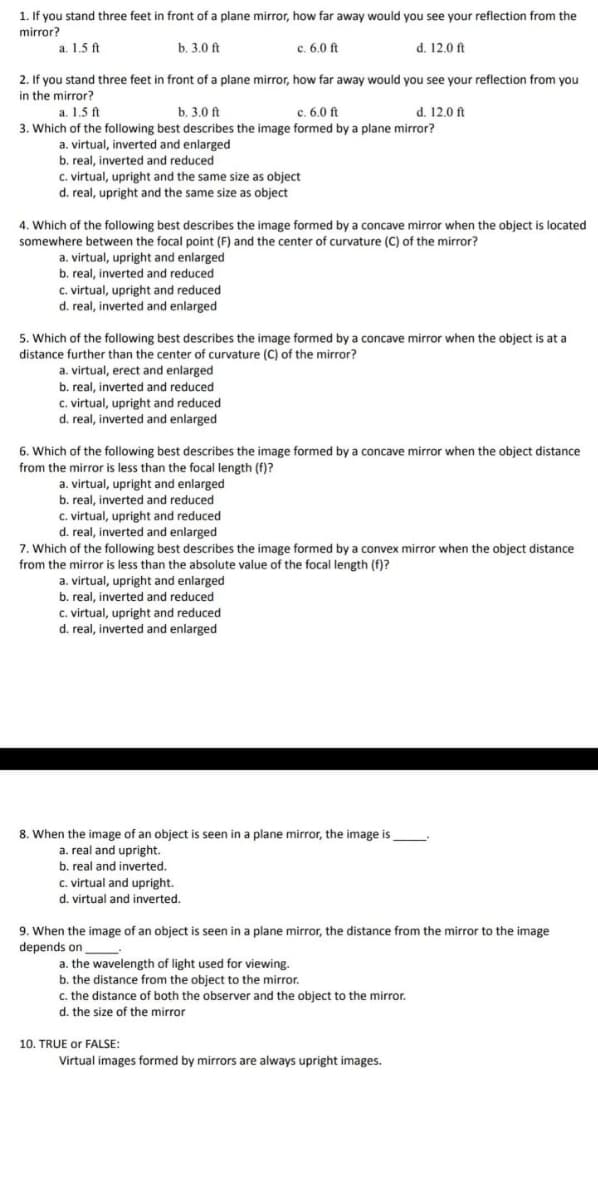9. When the image of an object is seen in a plane mirror, the distance from the mirror to the image depends on a. the wavelength of light used for viewing. b. the distance from the object to the mirror. c. the distance of both the observer and the object to the mirror. d. the size of the mirror 10. TRUE or FALSE: Virtual images formed by mirrors are always upright images.
9. When the image of an object is seen in a plane mirror, the distance from the mirror to the image depends on a. the wavelength of light used for viewing. b. the distance from the object to the mirror. c. the distance of both the observer and the object to the mirror. d. the size of the mirror 10. TRUE or FALSE: Virtual images formed by mirrors are always upright images.
College Physics
11th Edition
ISBN:9781305952300
Author:Raymond A. Serway, Chris Vuille
Publisher:Raymond A. Serway, Chris Vuille
Chapter23: Mirrors And Lenses
Section: Chapter Questions
Problem 52AP: The object in Figure P23.52 is mid-way between the lens and the mirror, which are separated by a...
Related questions
Concept explainers
Applications Of Reflection Of Light
When a light ray (termed as the incident ray) hits a surface and bounces back (forms a reflected ray), the process of reflection of light has taken place.
Sign Convention for Mirrors
A mirror is made of glass that is coated with a metal amalgam on one side due to which the light ray incident on the surface undergoes reflection and not refraction.
Question
9 10

Transcribed Image Text:1. If you stand three feet in front of a plane mirror, how far away would you see your reflection from the
mirror?
a. 1.5 ft
b. 3.0 ft
c. 6.0 ft
d. 12.0 ft
2. If you stand three feet in front of a plane mirror, how far away would you see your reflection from you
in the mirror?
a. 1.5 ft
b. 3.0 ft
c. 6.0 ft
d. 12,0 ft
3. Which of the following best describes the image formed by a plane mirror?
a. virtual, inverted and enlarged
b. real, inverted and reduced
c. virtual, upright and the same size as object
d. real, upright and the same size as object
4. Which of the following best describes the image formed by a concave mirror when the object is located
somewhere between the focal point (F) and the center of curvature (C) of the mirror?
a. virtual, upright and enlarged
b. real, inverted and reduced
c. virtual, upright and reduced
d. real, inverted and enlarged
5. Which of the following best describes the image formed by a concave mirror when the object is at a
distance further than the center of curvature (C) of the mirror?
a. virtual, erect and enlarged
b. real, inverted and reduced
C. virtual, upright and reduced
d. real, inverted and enlarged
6. Which of the following best describes the image formed by a concave mirror when the object distance
from the mirror is less than the focal length (f)?
a. virtual, upright and enlarged
b. real, inverted and reduced
c. virtual, upright and reduced
d. real, inverted and enlarged
7. Which of the following best describes the image formed by a convex mirror when the object distance
from the mirror is less than the absolute value of the focal length (f)?
a. virtual, upright and enlarged
b. real, inverted and reduced
c. virtual, upright and reduced
d. real, inverted and enlarged
8. When the image of an object is seen in a plane mirror, the image is
a. real and upright.
b. real and inverted.
c. virtual and upright.
d. virtual and inverted.
9. When the image of an object is seen in a plane mirror, the distance from the mirror to the image
depends on
a. the wavelength of light used for viewing.
b. the distance from the object to the mirror.
c. the distance of both the observer and the object to the mirror.
d. the size of the mirror
10. TRUE or FALSE:
Virtual images formed by mirrors are always upright images.
Expert Solution
This question has been solved!
Explore an expertly crafted, step-by-step solution for a thorough understanding of key concepts.
This is a popular solution!
Trending now
This is a popular solution!
Step by step
Solved in 2 steps

Knowledge Booster
Learn more about
Need a deep-dive on the concept behind this application? Look no further. Learn more about this topic, physics and related others by exploring similar questions and additional content below.Recommended textbooks for you

College Physics
Physics
ISBN:
9781305952300
Author:
Raymond A. Serway, Chris Vuille
Publisher:
Cengage Learning

College Physics
Physics
ISBN:
9781285737027
Author:
Raymond A. Serway, Chris Vuille
Publisher:
Cengage Learning

College Physics
Physics
ISBN:
9781938168000
Author:
Paul Peter Urone, Roger Hinrichs
Publisher:
OpenStax College

College Physics
Physics
ISBN:
9781305952300
Author:
Raymond A. Serway, Chris Vuille
Publisher:
Cengage Learning

College Physics
Physics
ISBN:
9781285737027
Author:
Raymond A. Serway, Chris Vuille
Publisher:
Cengage Learning

College Physics
Physics
ISBN:
9781938168000
Author:
Paul Peter Urone, Roger Hinrichs
Publisher:
OpenStax College

Physics for Scientists and Engineers, Technology …
Physics
ISBN:
9781305116399
Author:
Raymond A. Serway, John W. Jewett
Publisher:
Cengage Learning

Physics for Scientists and Engineers
Physics
ISBN:
9781337553278
Author:
Raymond A. Serway, John W. Jewett
Publisher:
Cengage Learning

Physics for Scientists and Engineers with Modern …
Physics
ISBN:
9781337553292
Author:
Raymond A. Serway, John W. Jewett
Publisher:
Cengage Learning